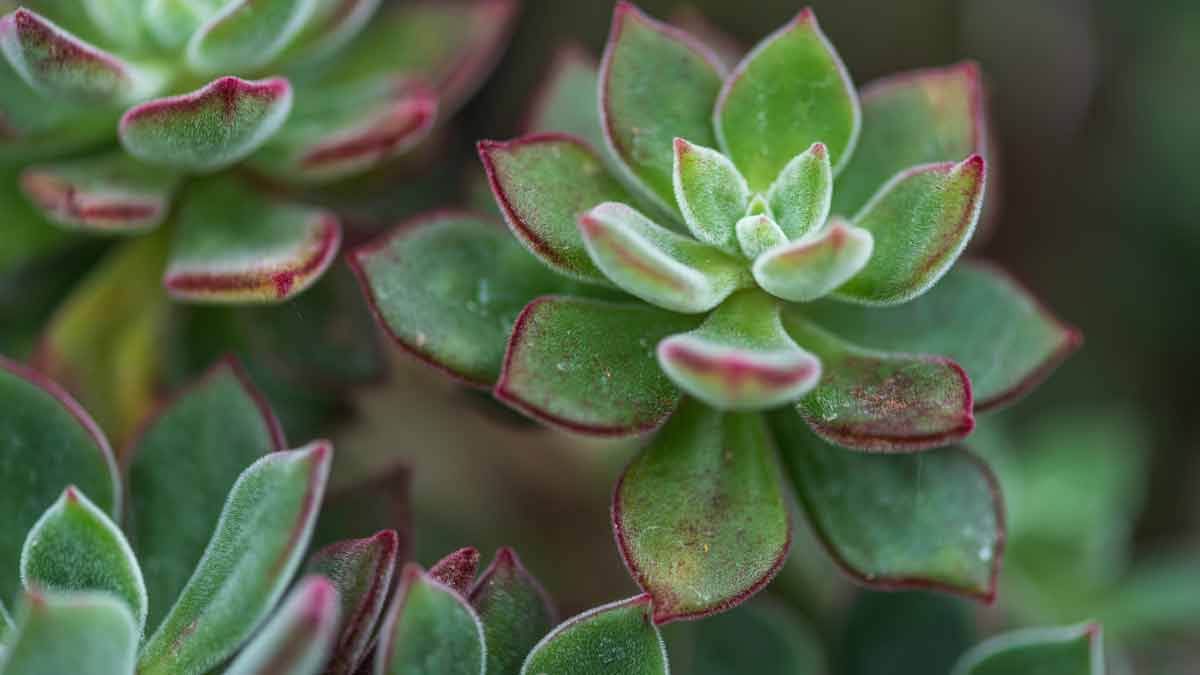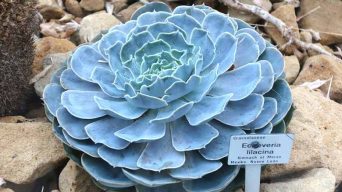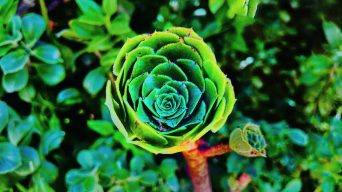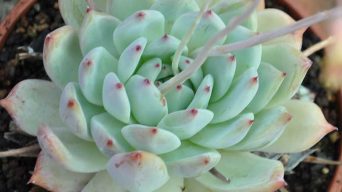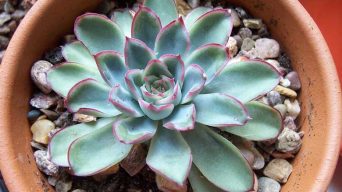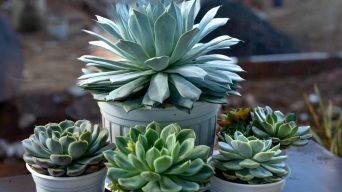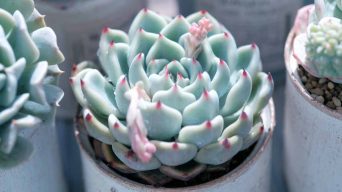Key Takeaways
- Improper watering is a primary reason for echeveria leaves falling off, which can be overwatering or underwatering. Water deeply but infrequently and use well-draining soil and containers to prevent this issue.
- Poor lighting conditions can lead to Echeveria leaf loss as these succulent plants require bright but indirect sunlight for healthy growth. Place your Echeveria near bright windows, or consider using grow lights if you don’t have access to sufficient natural light.
- Pest infestations, extreme temperatures, and diseases are common causes of echeveria leaves falling off. Inspect your plant regularly for signs of distress and take measures like providing appropriate temperature levels, identifying pests early on with insecticidal soaps or horticultural oils following label instructions, removing any affected leaves right away, treating fungal infections with fungicides applied according to the package’s instructions, keeping the area clean around your Echeveria plant free from debris that could harbor disease-causing agents among others.
Echeveria plants are beloved for their charming, fleshy leaves and eye-catching rosette shapes.
But when faced with the upsetting sight of your Echeveria’s leaves falling off, it’s time to take action.
This blog will delve into the common causes behind this phenomenon and offer practical solutions to help you bring your succulent back to its best form.
Common Causes Of Echeveria Leaf Loss
Echeveria leaf loss is often caused by over or underwatering, insufficient lighting, pest infestations, and extreme temperatures.
Overwatering Or Underwatering
One of the primary reasons behind echeveria leaves falling off is improper watering, which can be overwatering or underwatering.
Overwatered Echeveria succulents often exhibit swollen and mushy leaves that eventually drop from the plant due to root rot caused by excessive moisture in the soil.
On the other hand, underwatering can also lead to leaf loss, as succulents require sufficient hydration to thrive.
Depriving them of necessary moisture can cause their foliage to become weak, wilted, and fall off prematurely.
Maintaining a balance in watering habits is essential – overwatering and underwatering can adversely affect your echeveria succulent’s health.
Poor Lighting
One of the most common causes behind Echeveria leaves falling off is poor lighting, as these succulent plants require bright but indirect sunlight for healthy growth.
Insufficient light can lead to an elongated stem, weakened plant structure, and leaf loss.
To remedy this issue and promote proper growth for your Echeveria plant, ensure it’s placed in a location that receives at least six hours of bright yet indirect sunlight daily.
If achieving that isn’t possible due to insufficient window space or other factors, you can also utilize artificial grow lights to supplement natural light.
This will help prevent further leaf loss and enable your succulent to thrive under optimal lighting conditions.
Pest Infestations
Pest infestations can wreak havoc on your Echeveria, causing the leaves to fall off and leaving the plant susceptible to various diseases. Mealybugs are a common pest that targets these succulents, feasting on their sap and weakening the plant.
To combat mealybug infestations, you can use a cotton swab dipped in rubbing alcohol to remove them from your Echeveria gently.
Ensure you inspect every part of the plant as they often hide in crevices or under leaves.
For more severe cases, consider using insecticidal soaps or horticultural oils following label instructions for best results.
Watch for other pests, such as aphids and scale insects, which may also contribute to your succulent’s leaf loss issue.
Extreme Temperatures
Echeveria plants are susceptible to extreme temperatures, particularly those above 80°F, which can cause the leaves to fall off.
These succulents originate from areas with mild temperatures and thrive in climates where daytime temperatures range between 60°F to 70°F and nighttime temps at around 50°F.
When exposed to high heat or cold shock (below 40°F), Echeverias may experience stress that leads to leaf loss.
Plant owners must ensure their Echeverias aren’t placed near drafts or vents that could expose them to sudden temperature changes.
Also, prolonged drought periods without proper hydration can lead to Echeveria leaves drying out and falling off.
How To Treat Echeveria Leaves Falling Off
To treat echeveria leaves falling off, you can adjust your watering habits, improve lighting conditions, identify and eliminate pests and diseases, and maintain appropriate temperature levels.
Adjust Watering Habits
Adjusting your watering habits to prevent Echeveria leaves from falling off due to overwatering or underwatering is crucial.
Here are some tips on how to do so:
- Water deeply but infrequently: Succulents like Echeveria prefer a thorough soak when watered but don’t need frequent watering. Water them only when the top inch of soil has dried out completely.
- Use well-draining soil and containers: Good drainage is crucial for succulent plants like Echeveria. Make sure the pot has drainage holes to allow excess water to escape and use a well-draining soil mix that doesn’t retain too much moisture.
- Avoid watering during dormant periods: Echeveria goes through dormancy periods during the winter months, requiring less water than during active growth periods in spring and summer.
- Don’t let water sit in saucers: If you use saucers under your pots, empty any standing water after watering. Leaving your pots sitting in water can cause root rot and lead to leaves falling off.
- Monitor the moisture level: Regularly check the soil’s moisture level by sticking your finger about an inch into the soil. If it feels dry at that depth, it’s time to water again.
By following these tips and adjusting your watering habits accordingly, you can prevent Echeveria leaves from falling off due to improper moisture levels in the soil.
Enhance Lighting Conditions
Enhancing the amount and quality of light your plants receive is important to prevent succulent leaves from falling off due to poor lighting conditions.
Here are a few ways to do so:
- Place your succulents near a bright window that receives indirect sunlight for at least six hours daily.
- Consider using a grow light if you don’t have access to sufficient natural light. LED or full-spectrum lights work well and can be adjusted according to the needs of your particular plants.
- If your plants are located in an area with limited sunlight, consider moving them to a brighter spot or rotating them regularly to ensure they receive uniform exposure.
- Avoid exposing your succulents to direct sunlight for extended periods, which can lead to sun damage and cause leaves to fall off.
- Regularly dust off your plant’s leaves with a soft brush or cloth to help increase their ability to photosynthesize.
Identify And Eliminate Pests And Diseases
Identifying and eliminating pests and diseases is crucial to combat Echeveria leaf loss.
Here are some steps to take:
- Inspect your plants regularly for signs of infestation or disease, including discolored leaves, webbing, or visible pests.
- Remove any affected leaves or parts of the plant immediately, disposing of them safely.
- Treat pest infestations with insecticidal soap, neem oil, or another organic pesticide.
- Control fungal infections by applying a fungicide as directed on the package.
- Quarantine infected plants from healthy ones until the problem is solved to prevent spreading.
- Keep the area surrounding your Echeveria clean and debris-free to reduce disease risk.
By taking these essential measures, you can identify and eliminate pests and diseases that may cause Echeveria leaves to fall off.
Maintain Appropriate Temperature Levels
To prevent Echeveria leaves from falling off, it is crucial to maintain appropriate temperature levels.
Here are some tips on how to do it:
- Keep your Echeveria plant in a location with consistent temperatures between 60°F and 80°F.
- Avoid exposing your plant to extreme temperatures or sudden temperature fluctuations, as they can cause stress and lead to leaf drop.
- During the winter months, protect your Echeveria from cold drafts and provide extra insulation if necessary.
- If you live in a hot climate, consider providing shade or moving your plant indoors during the hottest parts of the day.
- Good air circulation is essential for maintaining appropriate temperature levels. Keep your Echeveria in a well-ventilated area with plenty of fresh air.
Remember that every Echeveria variety has its unique temperature preferences.
Research your specific type of plant and adjust your care accordingly.
Monitoring temperature levels can help ensure your Echeveria stays healthy and retains its vibrant foliage.
Preventative Measures To Stop Echeveria Leaf Loss
Selecting the proper containers and using well-draining soil are important to avoid losing leaves from your echeveria plant.
Additionally, be careful not to overwater or over-fertilize the plant, ensure it receives sufficient sunlight and ventilation, and regularly trim and propagate it.
Use Well-draining Soil And Suitable Containers
Using well-draining soil and suitable containers is one of the most important preventative measures to stop Echeveria leaf loss.
Here are a few tips to keep in mind:
- Use a soil mix that allows water to flow through it quickly. A mixture of sand, perlite, and cactus soil works well.
- Avoid heavy or clay soils that retain too much moisture, as this can lead to root rot and subsequent leaf loss.
- Choose containers with drainage holes that allow excess water to flow out easily. This prevents water from collecting in the bottom of the pot, which can cause root rot and leaf loss.
- Select pots that are the appropriate size for your Echeveria plant. If the pot is too large, excess soil will hold onto too much moisture, increasing the risk of root rot and leaf loss.
- Consider using pots made from materials like terracotta or unglazed ceramic, as these allow air to circulate around the roots and help prevent overwatering.
Rotate Plants For Uniform Sunlight Exposure
To ensure that your Echeveria plants receive uniform sunlight exposure, it is recommended to rotate them regularly.
This will prevent one side of the plant from receiving too much light while the other is left in the shade.
Here are some tips for rotating your Echeveria plants:
- Rotate the pot 180 degrees every 2 – 4 weeks.
- If you have multiple plants, switch their positions to ensure they all receive equal amounts of sunlight.
- Take note of any areas in your home or garden with indirect light, and move your Echeveria there when necessary.
- Avoid putting your Echeveria near windows with strong direct sunlight, which can cause sunburn.
By rotating your Echeveria plants, you can help avoid leaf loss caused by uneven lighting conditions.
Additionally, regular rotation encourages even growth and promotes healthier foliage.
Properly Acclimate Plants To New Environments
It’s important to properly acclimate your Echeveria plants when transferring them to new environments.
Here are some tips:
- Gradually introduce your plant to sunlight if it will be receiving more direct light than it was before. Start with just a few hours of morning sun and gradually increase the time it receives over several weeks.
- Similarly, if the temperature is different in the new environment, expose your plant progressively to the new temperature range over several days or weeks.
- Keep an eye on your plant during this transition period and adjust its care as necessary. For example, if the leaves are discolored or drooping, you may need to change the watering schedule or move it to a location with less direct sunlight.
- Be patient! It can take some time for your Echeveria plant to adjust to its new environment fully.
Use Fertilizers In Moderation
Over-fertilizing your Echeveria succulents can cause various problems, including leaf loss and stunted growth.
However, you can still use fertilizers to promote healthy growth if you follow these tips:
- Use a fertilizer formulated specifically for succulent plants.
- Apply the fertilizer sparingly and only during the growing season.
- Dilute the fertilizer according to package instructions to prevent overfeeding.
- Consider using organic or slow-release fertilizers to provide nutrients over a longer period.
- Be cautious when using foliar sprays, as they can burn succulent leaves if not applied correctly.
Regularly Prune And Propagate
Pruning and propagating are essential steps in maintaining the health of your Echeveria plant and preventing leaf loss.
Here are some tips to help you:
- Remove any dead or dying leaves regularly to promote healthy growth.
- Prune back any leggy or stretching stems to encourage a more compact plant.
- Propagate healthy leaves or rosettes by carefully removing them from the plant and allowing them to dry out for a few days before replanting.
- Use well-draining soil and containers with drainage holes for newly propagated plants.
- With proper care, your Echeveria will thrive, producing new growth while maintaining its overall shape and beauty!
Final Thoughts
Echeveria leaves falling off can be caused by various factors such as overwatering, poor lighting, pest infestations, and extreme temperatures.
Adjusting watering habits and enhancing the plant’s environment are essential solutions to treat this issue.
Preventative measures include using well-draining soil and suitable containers while propagating or regularly pruning.

